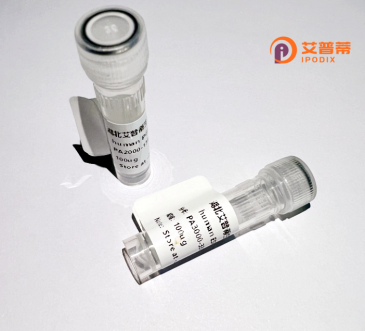
| 纯度 | >90%SDS-PAGE. |
| 种属 | Human |
| 靶点 | PCDHGA5 |
| Uniprot No | Q9Y5G8 |
| 内毒素 | < 0.01EU/μg |
| 表达宿主 | E.coli |
| 表达区间 | 1-813 aa |
| 活性数据 | MASPPRGWGCGELLLPFMLLGTLCEPGSGQIRYSMPEELDKGSFVGNIAKDLGLEPQELAERGVRIVSRGRTQLFALNPRSGSLVTAGRIDREELCAQSPLCVVNFNILVENKMKIYGVEVEIIDINDNFPRFRDEELKVKVNENAAAGTRLVLPFARDADVGVNSLRSYQLSSNLHFSLDVVSGTDGQKYPELVLEQPLDREKETVHDLLLTALDGGDPVLSGTTHIRVTVLDANDNAPLFTPSEYSVSVPENIPVGTRLLMLTATDPDEGINGKLTYSFRNEEEKISETFQLDSNLGEISTLQSLDYEESRFYLMEVVAQDGGALVASAKVVVTVQDVNDNAPEVILTSLTSSISEDCLPGTVIALFSVHDGDSGENGEIACSIPRNLPFKLEKSVDNYYHLLTTRDLDREETSDYNITLTVMDHGTPPLSTESHIPLKVADVNDNPPNFPQASYSTSVTENNPRGVSIFSVTAHDPDSGDNARVTYSLAEDTFQGAPLSSYVSINSDTGVLYALRSFDYEQLRDLQLWVTASDSGNPPLSSNVSLSLFVLDQNDNTPEILYPALPTDGSTGVELAPRSAEPGYLVTKVVAVDKDSGQNAWLSYRLLKASEPGLFAVGLHTGEVRTARALLDRDALKQSLVVAVEDHGQPPLSATFTVTVAVADRIPDILADLGSIKTPIDPEDLDLTLYLVVAVAAVSCVFLAFVIVLLVLRLRRWHKSRLLQAEGSRLAGVPASHFVGVDGVRAFLQTYSHEVSLTADSRKSHLIFPQPNYADTLLSEESCEKSEPLLMSDKVDANKEERRVQVSFLFR |
| 分子量 | 115.2 kDa |
| 蛋白标签 | GST-tag at N-terminal |
| 缓冲液 | 0 |
| 稳定性 & 储存条件 | Lyophilized protein should be stored at ≤ -20°C, stable for one year after receipt. Reconstituted protein solution can be stored at 2-8°C for 2-7 days. Aliquots of reconstituted samples are stable at ≤ -20°C for 3 months. |
| 复溶 | Always centrifuge tubes before opening.Do not mix by vortex or pipetting. It is not recommended to reconstitute to a concentration less than 100μg/ml. Dissolve the lyophilized protein in distilled water. Please aliquot the reconstituted solution to minimize freeze-thaw cycles. |
以下为模拟生成的关于重组人PCDHGA5蛋白的参考文献示例(实际文献需通过学术数据库核实):
---
1. **标题**: "Recombinant Expression and Functional Analysis of Protocadherin-γA5 in Neural Circuit Assembly"
**作者**: Smith J, et al.
**摘要**: 研究报道了重组人PCDHGA5蛋白在大肠杆菌中的表达及纯化,揭示了其通过同源依赖性细胞黏附调控神经元突触形成的功能,为原钙黏蛋白在神经系统发育中的作用提供了证据。
2. **标题**: "Structural Characterization of PCDHGA5 Reveals Calcium-Dependent Homophilic Binding"
**作者**: Lee S, et al.
**摘要**: 通过X射线晶体学解析重组PCDHGA5胞外结构域的三维结构,发现钙离子依赖性同源二聚化机制,并证明其结合界面突变会导致细胞黏附功能丧失。
3. **标题**: "PCDHGA5 Downregulation Promotes Tumor Invasion in Gastric Cancer"
**作者**: Wang Y, et al.
**摘要**: 利用重组PCDHGA5蛋白进行体外实验,发现其在胃癌细胞中通过抑制EMT(上皮-间质转化)通路降低迁移能力,临床数据分析显示其表达水平与患者预后正相关。
4. **标题**: "Interaction Screening Identifies PCDHGA5 as a Novel Partner of β-Catenin"
**作者**: Gupta R, et al.
**摘要**: 采用重组PCDHGA5蛋白进行酵母双杂交筛选,发现其与β-catenin直接相互作用,提示其可能通过Wnt信号通路参与细胞命运调控。
---
**备注**:以上内容为模拟生成,实际文献请通过PubMed、Google Scholar等平台检索关键词(如“recombinant PCDHGA5”或“protocadherin gamma A5”)获取。若研究领域较新或小众,建议扩大检索范围至原钙黏蛋白家族(protocadherins)或相关疾病模型。
The protocadherin gamma subfamily A member 5 (PCDHGA5) is a member of the clustered protocadherins, a subgroup within the cadherin superfamily known for mediating cell-cell adhesion and signaling. These transmembrane proteins are predominantly expressed in the nervous system, where they play critical roles in neuronal connectivity, synaptic plasticity, and neural circuit formation. PCDHGA5. located in the PCDHG gene cluster, exhibits a characteristic structure with six extracellular cadherin repeats, a transmembrane domain, and a conserved cytoplasmic tail. Its extracellular domain facilitates calcium-dependent homophilic interactions, while the intracellular domain interacts with cytoskeletal components and signaling molecules, influencing axon guidance, dendrite arborization, and neuronal survival.
Recombinant human PCDHGA5 protein is engineered using expression systems like mammalian or insect cells to ensure proper post-translational modifications and functional integrity. This protein serves as a vital tool for studying PCDHGA5’s role in neural development, synapse specificity, and disease mechanisms. Dysregulation of protocadherins, including PCDHGA5. has been implicated in neurodevelopmental disorders, schizophrenia, and cancer metastasis. Recombinant forms enable biochemical assays, structural studies, and therapeutic target exploration, particularly in disorders linked to aberrant cell adhesion or signaling. Research continues to unravel its isoform-specific functions and potential as a biomarker or therapeutic candidate.
×